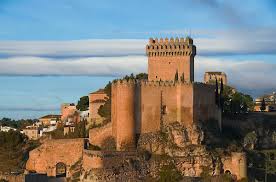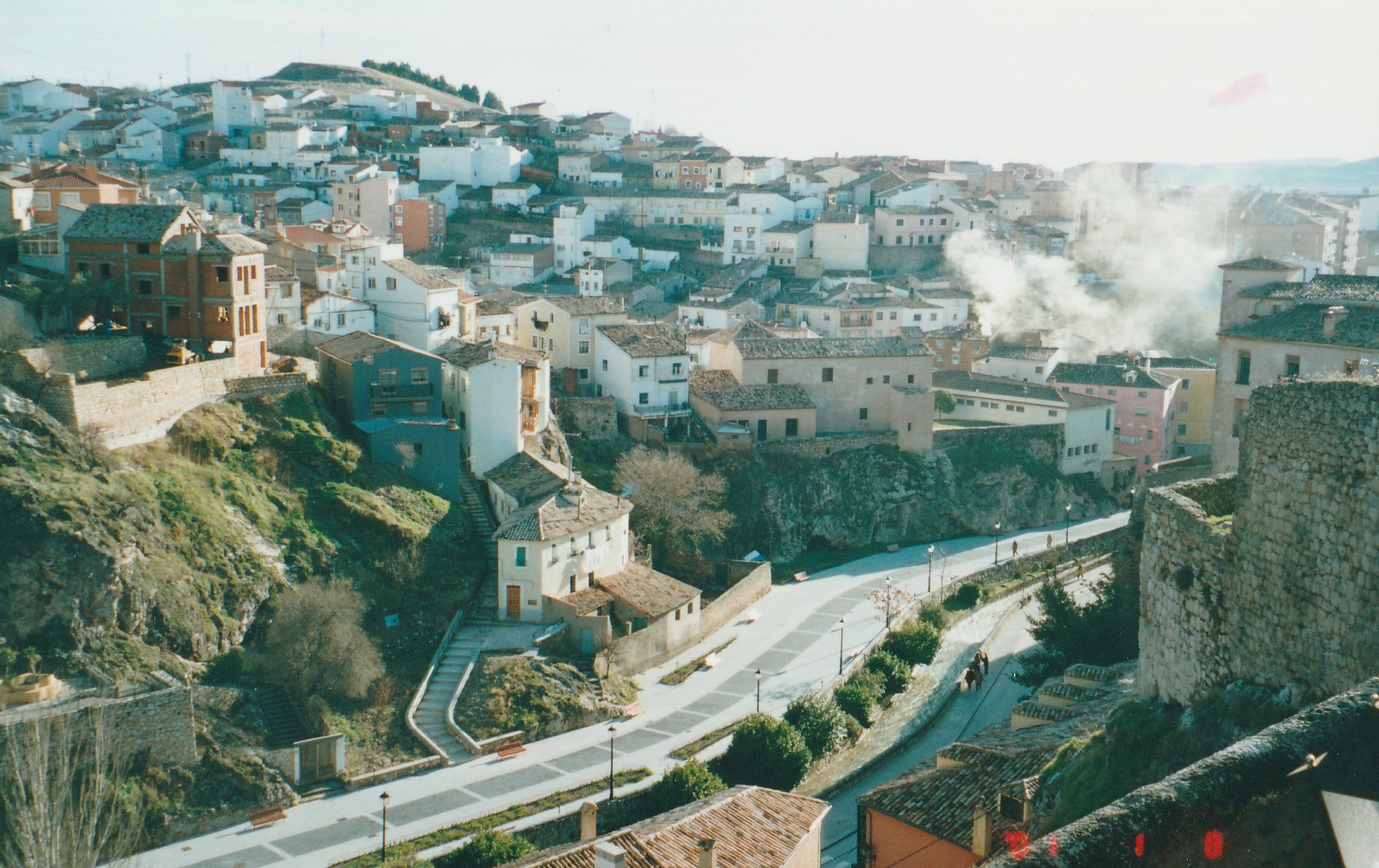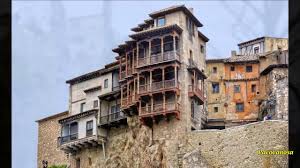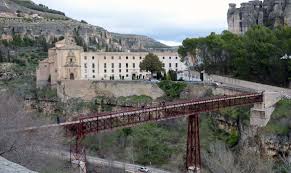What better way to get to Cuenca than via Spain’s own Grand Canyon. A spectacular gorge eroded by the River Jucar in Albacete – a sight not to be missed.

From Alicante take the N330 (toll free) motorway towards Madrid. Leaving behind the outlying industrial estates you pass through an area of arid, stony badlands. After a few more kilometres the landscape becomes more gentle with the semi-desert giving way to an agricultural plain planted with olive groves, almond orchards and vineyards.
One stop worth making along here is Novelda the heart of Spain’s marble industry. Another link – video – Novelda . As you enter the town you will see Cylopean blocks of the previous rock waiting to be sliced into highly polished wafers. The main reason to visit Novelda is to see its Art Nouveau house built in 1903 it has now become immaculately restored complete with period furniture .
The motorway continues up the industrial Vinalopo valley following the Sierra del Maigmo (to the right) From this side the mountains give little indication of the lush woodlands that cover their north-facing slopes.
At one time this valley was a frontier between Moorish and Christian lands. A line of castles, more impressive from a distance than close up, still stands guard along the route.
Keep on the motorway merging on to the N430 to Almansa. Its castle, standing proud from the plain on the crest of a solitary rock, is a landmark and a witness to history. This was the scene of a pivotal battle in the War of the Spanish Succession.

Almansa Castle
Head towards Albacete but after about 12 kms leave motorway for Alpera on the AB860 and carry straight on for Alcala del Jucar. After 40 km of rolling farmland, punctuated by pretty, flower-strewn slopes, the land suddenly drops away into the deep spectacular gorge that the River Jucar carves across the plains of Albacete.
The road snakes down to the bottom of the canyon to reach Alcala del Jucar . Brilliant white to match the rock, the village looks as if it had been glued precariously to the inner curve of a tight river meander. It spills down the steep slope from the walls of its castle-perched on a rocky pinnacle-to an old stone bridge that bounds across the river below
Alcala has few streets and it is impossible for cars to enter the village. There are endless steps, ramps, alleys and passage-ways decorated with colourful, old doors., and flowerpots.
A good way to begin a visit is to climb to the top of the restored castle – just keep going uphill, you can’t miss it, and get your bearings. Far more interesting than the few other public buildings are the ordinary houses of the village. Some ramble in all directions, with uneven floors, narrow staircases, pigeon lofts and secret courtyards.
There is more to these houses than meets the eye. Those that back onto the soft chalk usually have extra rooms excavated at the back and quite a few have tunnels that pierce the meander and emerge up to 90 metres away. You can see these in the video earlier.
Leaving the Jucar behind you pick up the AB863 to Casas Ibanez. Cross the N322 and carry on across country through Villalpardo on the CU820 When you meet the N111 turn left – turn right in Motilla del Palncar at the end of the town onto the N320.
There is one worthwhile detour before heading for Cuenca: it can even be an overnight stop (but we only had a drink) The stunning castle of Alarcon 17 km from Motilla hanging over another deep valley of the Jucar.

To get there take the N111 towards Madrid and turn off at the signposted turning after 14km. The Moors considered the castle to be impregnable, although in 1184 the Christians still managed to take it. According to legend, Fernan Martin de Ceballos scaled its walls at night using two daggers dug into the cement between the stones. The castle is now a Parador. Brochure in file.
From Alarcon you have to return to Motilla del Palancar to pick up the N320 which takes you at last towards Cuenca through rich plouged lands, holm oak scrub and pleasant pine woods, which provide shady places to stop and stroll.
The entrance to Cuenca (pop 43,000) through an industrial zone, comes as something of an anticlimax after the memorable locations en route and belies the beauty of a city and a province worth of a lengthy visit. We stayed here for two days choosing two different hotels: The Leonor de Aquitania and the Posada de San Jose (preferable) see info in file. There is also a Parador but both the above are in the old town near the hanging houses and good for walking and studying the area.
We only took a couple of photos this trip


Had a wonderful meal and brilliant service at the Las Brasas Don’t miss seeing the Casas Colgada “Hanging Houses” The city’s trademark and now Museum of Abstract Art.

For a good view cross the nearby Puente San Pablo. No one knows who built them but it is thought they were there in some form in the 15th Century.

Visit the Cathedral and then another wonderful trip is into the countryside as we did to see the Ciudad Encantada (the enchanted garden). This trip takes you through some of the most picturesque and varied scenery of the green and beautiful Serrania de Cuenca: past wondrous rock formations, through lush woods and along river banks to fairy-tale waterfalls.
There are many brochures and maps in the file.
To leave the city take Calle Colon over the bridge and turn right immediately for Ciudad Encantada. Follow the turquoise river through the gorge under cliffs of smoothly rounded rocks.
As it emerges from the gorge, the road passes under a bridge. Turn left after it onto the CU912 for Valdecabras, crossing the same bridge you have just driven under. This road runs up a tree-filled valley which gradually narrows until it enters a small rocky gorge. You leave the village of rustic stone houses clustering around a monolithic church to the right and climb the side of the valley into the woods above.
After a while, large rock formations appear among the trees: a foretaste of what is to come. Without further warning, you drive straight into the car park of the Enchanted City.
The rock formations of Ciudad Encantada are karst formations made of limestone and dolomite, which date back to the Cretaceous period, approximately 90 million years ago.[1] Rain falling on the original limestone plateau wore down the porous limestone, leaving behind the more resistant dolomite. Because the dolomite was not always distributed evenly in the original rock, the result was the irregularly eroded shapes that form the Ciudad Encantada. Brochure in the file. Well seen in this video
Fortunately, when we visited way out of season there were no tourists – in fact, nobody at all! There was snow and ice on the ground and there was something awesome about this remarkable collection of naturally sculpted rocks. You can stop and eat at the bar-restaurant and then leave by the road ahead which rises and falls through the woods, gradually dropping down to rejoin the CU921 along the Jucar valley.
We then cut across country as we had booked the third night in a hotel in Huete
“The Conde de Garcinarro” a beautifully converted baroque mansion house. This is every inch a noble Castilian residence:fine portal of dressed sandstone, coat of arms above, grilled windows and beyond an enormous studded door leading through to the collonaded courtyard. Climb a wide walnut staircase to the first floor. Bedrooms are vast with high ceilings. See video. Unfortunately they did not do evening meals so we had to go opposite the a very Spanish Bar where we were welcomed and had a lovely meal watching football and bullfighting. Breakfast was served in the hotel in the old kitchen on bright chequered table cloths – we then went off to discover the delights of this wild and untouristy part of Castile. Brochure in the file.
Then back home via Tarancon – Alarcon – Utiel and Valencia